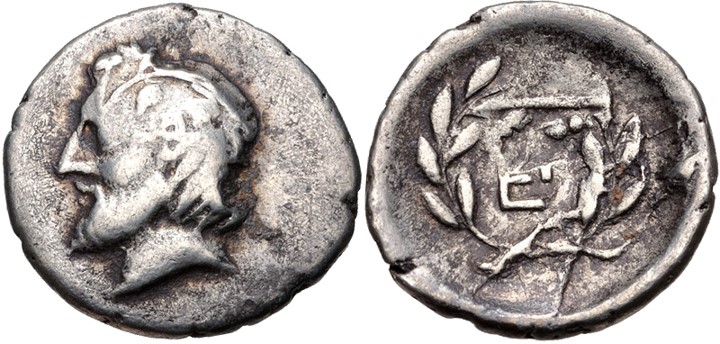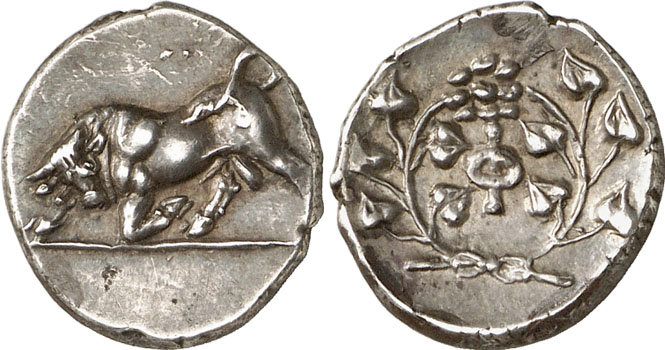295 BCE - 250 BCE | monogram (EΠ)
Overstriking coin
SO 11 - Epidaurus over Phlius.jpg
Overstruck variety
SO 6 - Epidaurus over Phlius overstruck variety visible on the overstriking coin.jpg [LHS Numismatik AG, 102, 29 April 2008, lot 205]
Description
| ObverseInscription or printing placed on the obverse.:
|
Head of Asclepius left, wearing laurel wreath.
|
ReverseInscription or printing placed on the reverse.:
|
monogram (EΠ) (Greek) Monogram within laurel wreath.
|
Mint and issuing power
| MintIdentifies the place of manufacture or issue of a numismatic object.:
|
Epidaurus
|
Ancient regionAncient region.
|
Peloponnesus (Argolis)
|
Modern countryModern country: Greece
|
AuthorityIdentifies the issuing power. The authority can be "pretended" when the name or the portrait of X is on the coin but he/she was not the issuing power. It can also be "uncertain" when there is no mention of X on the coin but he/she was the issuing power according to the historical sources:
|
|
Chronology
| FromIdentifies the initial date in a range assigned in a numismatic context. 295 BCE toIdentifies the final date in a range assigned in a numismatic context.. 250 BCE
|
Classical 480-323 BC  periodTime period of the numismatic object. periodTime period of the numismatic object.
|
Physical description
MetalThe physical material (usually metal) from which an object is made.: Silver 
|
WeightWeight of the numismatic object (in grams). in grams: 2.762.76 g <br />2,760 mg <br />
|
DenominationTerm indicating the value of a numismatic object. Examples: tetradrachm, chalkous, denarius.: hemidrachm 
|
AxisDescribes the directional relationship between the obverse and reverse of a numismatic object.: 1212 mm <br />1.2 cm <br />
|
| DiameterDescribes diameter of an object (in mm).: 1818 mm <br />1.8 cm <br />
|
StandardStandard.: Aeginetic
|
References
Description
| ObverseInscription or printing placed on the obverse.:
|
Bull butting to left, head lowered and turned to face the viewer.
|
ReverseInscription or printing placed on the reverse.:
|
Φ (Greek) Φ within ivy wreath with four inner leaves, and rosette of nine berries above.
|
Mint and issuing power
| MintIdentifies the place of manufacture or issue of a numismatic object. ᵖ:
|
Phlius
|
Ancient regionAncient region. ᵖ
|
Peloponnesus (Phliasia)
|
Modern countryModern country: Greece
|
AuthorityIdentifies the authority in whose name (explicitly or implicitly) a numismatic object was issued. ᵖ:
|
|
Chronology
| FromIdentifies the initial date in a range assigned in a numismatic context. 280 BCE toIdentifies the final date in a range assigned in a numismatic context.. 270 BCE
|
Hellenistic 323-30 BC  periodTime period of the numismatic object. periodTime period of the numismatic object.
|
Physical description
| DenominationTerm indicating the value of a numismatic object. Examples: tetradrachm, chalkous, denarius. ᵖ:
|
hemidrachm 
|
|
|
References
References
- a b LHS Numismatics, 96 (Coins of Peloponnesos. The BCD Collection), 8-9 May 2006 (1775 lots)
- ^ Hoover, Oliver D. (2011), Handbook of Greek Coins 5. Coins of the Peloponnesos, Achaia, Phleiasia, Sikyonia, Elis, Triphylia, Messenia, Lakonia, Argolis, and Arkadia, Sixth to First Centuries BC, Lancaster (PA), 2011.

